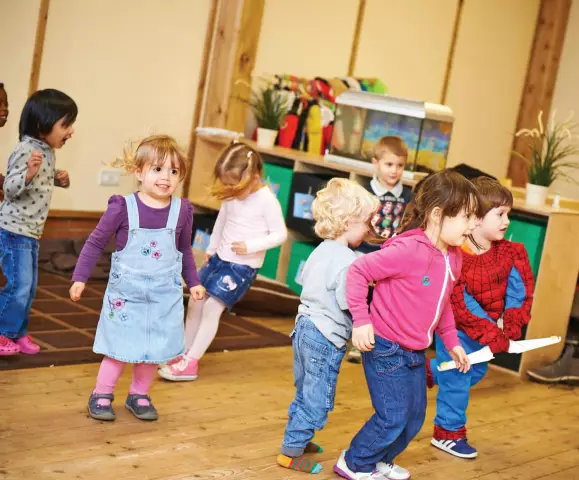- Author Rachel Wainwright [email protected].
- Public 2023-12-15 07:39.
- Last modified 2025-11-02 20:14.
9 month old baby

At 9 months, a child can do a lot: he is actively crawling, trying to get up, or is already standing on his own with support. Some toddlers may take their first awkward steps while walking around the house while holding their parents' hand.
Nine-month-old babies begin to show character, for example, they may turn away from the porridge, demanding tasty puree, or protest against the stroller, trying to get out of it. Babies sleep less during the day and are more awake, and also require a lot of parental attention and actively explore the world.
Physical and mental development of a 9 month old baby
The body weight of a child in the ninth month of life increases by about 500 g. On average, a baby born at 3.2-3.5 kg now weighs 9-9.5 kg. A 9-month-old baby is 70-72 cm tall. Boys are usually 1-2 cm taller than girls.
In the ninth month, babies already know how to sit well, they can easily lie down from a sitting position, and then just as easily sit down. The baby's arms have become stronger to such an extent that he can stand up, holding on to the playpen, chair or sofa, but it’s hard for him to stand on his legs for a long time, so he often falls, letting go of the support, and then gets up again, repeating the same actions many times …
The development of the child's speech continues, and new words appear in his vocabulary: "am", "baba", "give", etc. The kid tries to simulate his own voice, talking quietly or loudly.
In raising a child at this age, there are two main tasks:
- Development of speech and language;
- Formation of purposeful movements.
When communicating with the baby, reading books to him, it is necessary to try to make the child repeat certain sounds and syllables.
In children at 9 months, observation and imitative reaction are pronounced, they look at their parents and try to repeat after them. Using this opportunity, you can teach your child new, more complex actions, for example, putting toys in a bucket or taking them out of a closet.
At 9 months, a child is able to perform the following actions:
- Clap;
- Stand with mom's help;
- Play with two toys in both hands;
- Crawl holding an object in one hand;
- Copy the behavior and emotions of other children;
- Say "mom", "baba", "dad", "am", "give";
- Fulfill simple requests;
- Simulate someone's coughing, laughing, or sneezing
- Choose your toys carefully.
9 month old baby regimen
There are practically no changes in the baby's day regimen for 9 months. The child still wakes up around 6-7 in the morning, and falls asleep at about 22 hours. The number of feedings per day remains the same - 5 times.
In the mode of a 9-month-old child, three daily naps of 1.5-2 hours are maintained, but some children can switch to 2-time sleep, while the duration of each one slightly increases and is 2-2.5 hours.
The periods of wakefulness become more and more prolonged, and after feeding the baby does not sleep for 1.5-2 hours, and sometimes more. This time is filled with play and communication with parents.
The morning of the baby traditionally begins with washing, from 9 months you can try to put the baby on the pot in the morning.
In the morning, tempering procedures, morning exercises and massage are carried out.
You should walk with your child at least 2-3 times a day. The duration of the walk, especially in summer, should be 2.5-3 hours.
Traditional bathing before bedtime can be done less often, because the baby has already grown up. But water procedures for crumbs at this age become a real joy. Therefore, many parents continue to bathe their children every day.
After bathing, you must adhere to a certain ritual of going to bed - sing a lullaby, pat on the head or shake the baby. This will help your baby fall asleep faster.
Features of the diet and menu of a 9-month-old baby
Up to a year, the baby eats 5 times a day, and with each month the diet should become more varied and close to adult food.
The main menu for a 9 month old baby is still breast milk or adapted formula. Various cereals are added to them, buckwheat, corn, oat and rice are especially useful. The baby's vegetable menu includes cauliflower, carrots, broccoli, pumpkin, squash, green peas, as well as potatoes and lettuce.
Only healthy cooking methods are allowed: steaming, boiling or baking. For a baby at this age, it is better not to salt food, and to make it less bland, you can add fresh herbs to the dish. For example, chop the parsley thoroughly and mix with the puree.
At 9 months, a child can chew food, but this does not mean that he can be given food in pieces. It is enough to change the consistency of the puree by rubbing it not through a sieve, but kneading it with a fork or spoon.
You should continue to teach your baby to eat with a spoon, but you need to be patient, because, trying to imitate adults, children do not always immediately cope with the complex skill of managing cutlery.
An approximate menu for a 9-month-old baby looks like this:
- 6.00 - 200 g of breast milk or formula;
- 10.00 - 120-130 g of milk porridge with fruit puree or butter;
- 14.00 - 150 g vegetable puree, steam cutlet of meat or fish, egg yolk (every other day), compote or fruit juice;
- 18.00 - 120 g of breast milk or formula, 50 g of cottage cheese, cookies and fruit juice;
- 22.00 - 200 g of breast milk or formula.
When drawing up the menu, you should focus on the child, since the appetite and tastes of all children are different.
Educational games for 9 month old baby
In the 9 month old mode, there is more and more time when he is awake. Knowing how to crawl, the baby easily gets to different corners of the apartment, so he needs constant supervision. The territory on which the baby moves should be as safe as possible.
It is possible to satisfy the child's cognitive needs through constant games, looking at illustrated books about animals, insects, and household items. Nature walks are also very informative, especially in spring and summer. The kid needs to be told about everything that surrounds him.

It is very useful to develop fine motor skills of hands with the help of games, using large beads, buttons, pebbles, cereals and other objects as auxiliary materials. Since children at this age tend to taste everything, you should carefully monitor the baby so that he does not accidentally swallow any small object.
At 9 months old, you can play hide and seek with your baby. The baby is especially delighted with the situation when an adult hides around the corner, and then, showing himself for a second, makes a "cuckoo" sound.
The correct daily routine not only improves the child's mood, but also gives freedom to his parents. The baby acquires useful habits and skills, for example, washing in the morning and bathing in the evening, eating at a certain time, sleeping and getting up in the morning “by the clock”. All this will be useful to the child in life, and parents will not have problems teaching him new rules at an older age.
YouTube video related to the article:
Found a mistake in the text? Select it and press Ctrl + Enter.






